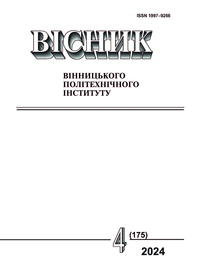Selection of Optimal Battery Capacity of the Household Prosumer
DOI:
https://doi.org/10.31649/1997-9266-2024-175-4-30-36Keywords:
energy storage systems, renewable energy sources, prosumer, optimization, modeling of energy consumptionAbstract
With the deepening of the "renewable energy source-household load-energy storage system" interaction and the development of demand response technology, the emergence of prosumers has led to the need to optimize the microgrids operation. This paper proposes a new optimization technique using a linear programming method to solve the problem of optimal planning of distributed energy resources, including photovoltaic systems and energy storage systems. Optimization of the operation of energy storage systems is a complex problem as it has special limitations, such as requirements for depth of discharge, state of charge limitations, charge and discharge rates, etc. According to the level of generation and load, supplied by the microgrid, the costs of the energy storage system in the consumer, an objective function is established to optimize the capacity of the energy storage system. The purpose of the study is to find the balance of unused energy at the end of the simulated day. In this work, the main goal of optimization is to find the minimum value of the energy storage systems capacity, which provides all the needs of the consumer’s load for the given power of the photovoltaic systems. The strategy of electricity consumption has been developed, aimed at maximization of the the autonomy of the prosumer. The optimal values of battery capacities determined, using the direct search method were simulated and presented. The results of battery capacities are given for the same prosumer with different power values of the rooftop solar power plant. The analysis of the dependence of the battery capacity on the value of the installed power of the photovoltaic systems of the prosumer was carried out. The optimization problem is modeled and solved using Matlab optimization toolkit.
References
L. Gruber, T. Klatzer, and S. Wogrin, Developing a Framework for Multiple Participation in Energy Communities. 2023. https://doi.org/0.36227/techrxiv.23294795.v1 .
O. Kulapin, A. Ivakhnov, D. Danylchenko, S. Fedorchuk, V. Hrytsenko, and D. Stanislav, “Prospects of Using Prosumers to Analyze the Potential of Demand Management,” in 2022 IEEE 3rd KhPI Week on Advanced Technology (KhPIWeek), 2022, pp. 1-5. https://doi.org/10.1109/KhPIWeek57572.2022.9916321 .
M. Marzband, M. Javadi, S. A. Pourmousavi, and G. Lightbody, “An advanced retail electricity market for active distribution systems and home microgrid interoperability based on game theory,” Electr. Power Syst. Res., no. 157, pp. 187-199, 2018. https://doi.org/10.1016/j.epsr.2017.12.024 .
C. D. Korkas, S. Baldi, and E. B. Kosmatopoulos, “Grid-Connected Microgrids: Demand Management via Distributed Control and Human-in-the-Loop Optimization,” Advances in Renewable Energies and Power Technologies, Elsevier, 2018, pp. 315-344. https://doi.org/10.1016/B978-0-12-813185-5.00025-5 .
M. Guo et al., “Access Point And Capacity Optimization Planning Method Of Virtual Power Plant,” in 2021 IEEE 5th Conference on Energy Internet and Energy System Integration (EI2), 2021, pp. 1877-1881. https://doi.org/10.1109/EI252483.2021.9712891 .
M. Ruiz-Cortés et al., “Optimal Charge/Discharge Scheduling of Batteries in Microgrids of Prosumers,” IEEE Trans. Energy Convers., vol. 34, no.1, pp. 468-477, 2019. https://doi.org/10.1109/TEC.2018.2878351 .
B. Kumaran Nalini, Z. You, M. Zade, P. Tzscheutschler, and U. Wagner, “OpenTUMFlex: A flexibility quantification and pricing mechanism for prosumer participation in local flexibility markets,” Int. J. Electr. Power Energy Syst., no. 143, pp. 108382, 2022. https://doi.org/10.1016/j.ijepes.2022.108382 .
C. Korkas, S. Baldi, I. Michailidis, and E. Kosmatopoulos, “Occupancy-based demand response and thermal comfort optimization in microgrids with renewable energy sources and energy storage, ” Appl. Energy, no. 163, pp. 93-104, 2016, https://doi.org/10.1016/j.apenergy.2015.10.140 .
M. Secchi, G. Barchi, D. Macii, D. Moser, and D. Petri, “Multi-objective battery sizing optimisation for renewable energy communities with distribution-level constraints: A prosumer-driven perspective,” Appl. Energy, no. 297, pp. 117-171, 2021, https://doi.org/10.1016/j.apenergy.2021.117171 .
M. Fice, and K. Dębowski, “Energy management in a semi off-grid prosumer micro system,” 2016 13th Selected Issues of Electrical Engineering and Electronics (WZEE), 2016, pp. 1-6. https://doi.org/0.1109/WZEE.2016.7800204 .
N. A. Shan, Y. Li, and H. Li, “Motivations behind P2P energy trading: a machine learning approach,” Int. J. Chin. Cult. Manag., vol. 5, no. 3, с. 189, 2022. https://doi.org/10.1504/IJCCM.2022.123645 .
A. Boumaiza, and A. Sanfilippo, “Energy Prosumer for Local Energy Marketplace,” в 2023 IEEE International Conference on Industrial Technology (ICIT), с. 1-5, 2023. https://doi.org/10.1109/ICIT58465.2023.10143096 .
U. Cali and A. Fifield, “Towards the decentralized revolution in energy systems using blockchain technology, ” Int. J. Smart Grid Clean Energy, pp. 245-256, 2019. https://doi.org/10.12720/sgce.8.3.245-256 .
О. В. Кулапін і К. В. Махотіло, «Моделювання смарт-мережі споживачів-просьюмерів з фотоелектричними системами», 2019, [Електронний ресурс]. Режим доступу: https://repository.kpi.kharkov.ua/handle/KhPI-Press/46363 . Дата звернення: 08, Червень 2024.
H. Chen, T. Cong, W. Yang, C. Tan, Y. Li, and Y. Ding, “Progress in electrical energy storage systems: a critical review. Prog Nat Sci,” Prog. Nat. Sci., no. 19, pp. 291-312, 2009. https://doi.org/10.1016/j.pnsc.2008.07.014 .
О. Кулапін і К. Махотіло, «Моделювання графіків навантаження просьюмера на базі поведінкового підходу,» POWER Eng. Econ. Tech. Ecol., no. 1, 2024. https://doi.org/10.20535/1813-5420.1.2024.297584 .
Downloads
-
pdf (Українська)
Downloads: 97
Published
How to Cite
Issue
Section
License

This work is licensed under a Creative Commons Attribution 4.0 International License.
Authors who publish with this journal agree to the following terms:
- Authors retain copyright and grant the journal right of first publication.
- Authors are able to enter into separate, additional contractual arrangements for the non-exclusive distribution of the journal's published version of the work (e.g., post it to an institutional repository or publish it in a book), with an acknowledgment of its initial publication in this journal.
- Authors are permitted and encouraged to post their work online (e.g., in institutional repositories or on their website) prior to and during the submission process, as it can lead to productive exchanges, as well as earlier and greater citation of published work (See The Effect of Open Access).





